The Bureau of Economic Analysis announced today that seasonally adjusted U.S. real GDP grew at a 33.1% annual rate in the third quarter. That’s the largest change ever recorded, even bigger than the -31.4% annual rate now reported for 2020:Q2. What do those numbers tell us?
The first thing to note is that “annual rate” refers to what the growth rate would be if growth were to continue for a full year at the pace observed in the third quarter. It’s often helpful to think in terms of those units. But in this case, there is zero possibility that growth will continue at this pace. Real GDP in Q3 was actually 1.074 times as big as real GDP in Q2. The calculation 1.0744 = 1.331 is where the reported 33.1% number comes from.
The second thing to note is that even if real GDP had fallen by 31% in Q2 and grown by 33% in Q3 (which they didn’t), that wouldn’t leave us ahead of where we started. Because real GDP was so much lower in Q2 than in Q1, 31% of Q1 GDP (the base used to calculate a growth rate in Q2) is a much bigger number than 33% of Q2 GDP (the base used to calculate a growth rate in Q3). A 30% drop followed by a 30% gain would actually leave us down on net by 9% (0.7 x 1.3 = 0.91). This is one of many reasons why many economists prefer to use logarithms rather than percent changes. The change in the log of real GDP in Q2 was -0.094 and the change in Q3 was 0.071. Adding those two changes together gives -0.023, which is the correct summary of the situation: real GDP was about 2.3% lower in Q3 than it had been in Q1.
To quote log changes at an annual rate, we could multiply the quarterly change in the logarithm by 4 if we thought the situation might continue for a full year. Another way to report the data at an annual rate is to use the year-over-year change in the log, as in the graph below.
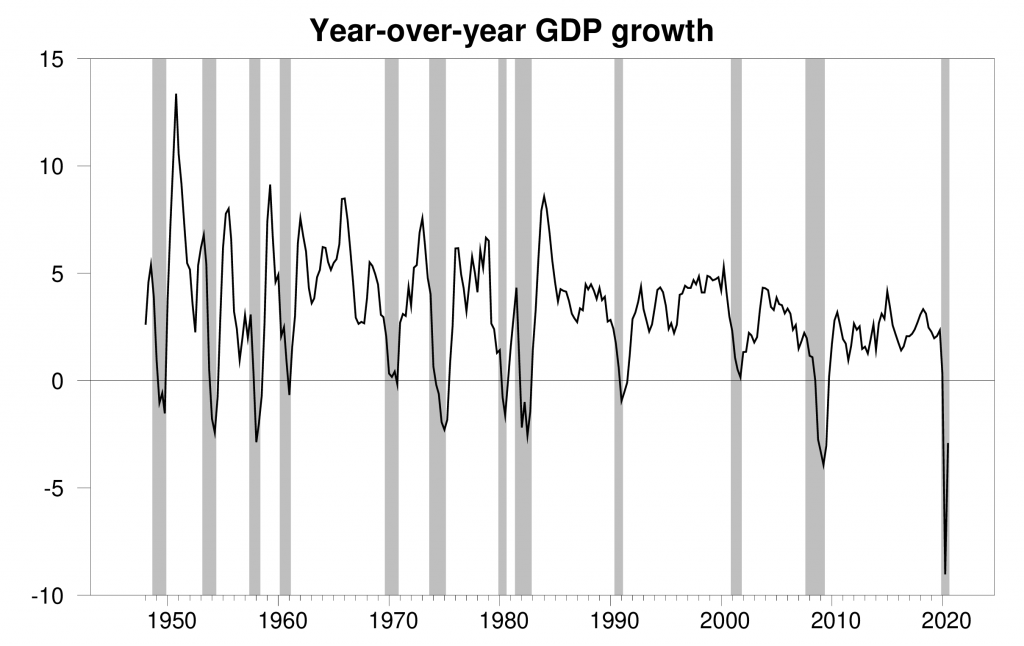
100 times the difference between the natural log of real GDP in quarter t and the value in quarter t-4. Raw data from FRED.
None of this should distract us from acknowledging just how remarkable both the Q2 and Q3 numbers are. One measure of how unusual they are is based on the standard deviation of quarterly changes in the log of real GDP over 1947:Q2 to 2019:Q4. An observation that is 5 standard deviations from the historical average, or a 5-sigma event, is sometimes called a “black swan” — something that is not at all expected, until you see one. The fall in real GDP in Q2 was an 11-sigma event, and the increase in Q3 was a 7-sigma event. Both extremely remarkable. But combined they leave us 4 sigmas short of where we were in Q1, which itself was already down from normal.
These numbers bring the Econbrowser recession indicator index up to 100.0% for Q2. As we’ve done every quarter for the last 15 years, we wait for one quarter of data revisions and updates before calculating the value for the previous quarter. Thus the number posted today (100.0%) is an assessment of the situation of the economy in 2020:Q2. The index had already been up to 97.1 for 2020:Q1. There is no question that we should count 2020:Q1 and Q2 as part of the 12th postwar U.S. recession. We will wait until the Q4 GDP data release before calculating a value for Q3, though it’s quite clear now that unless the numbers get drastically revised, the recession could now be said to be over and we’ve begun the recovery phase.
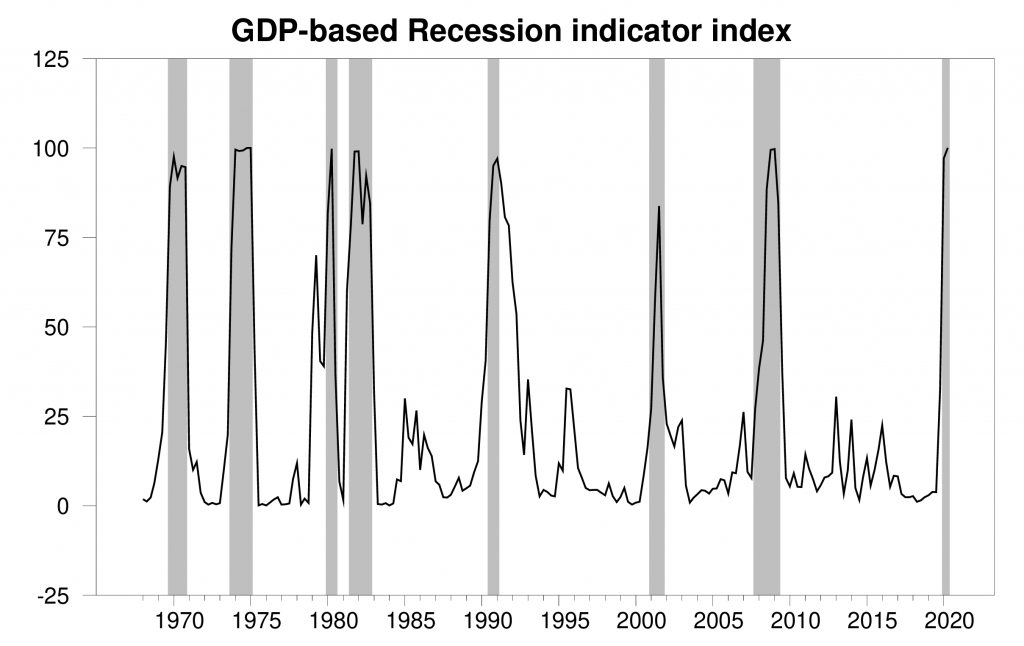
GDP-based recession indicator index. The plotted value for each date is based solely on the GDP numbers that were publicly available as of one quarter after the indicated date, with 2020:Q2 the last date shown on the graph. Shaded regions represent the NBER’s dates for recessions, which dates were not used in any way in constructing the index.
The convention of designating a 5-sigma event as a “black swan” is based in part on the assumption that the data could be characterized as coming from a Normal distribution. For a Normally distributed random variable, getting an observation 5 standard deviations away from the mean is truly extraordinary. But it’s abundantly clear that GDP growth is not Normally distributed. Indeed, the statistical framework underlying our recession indicator index is the idea that GDP growth comes from a mixture of Normal distributions corresponding to different phases of the business cycle. To adequately characterize the Q2 and Q3 observations, we’d probably want to add a third distribution that could describe these two observations alone. Michele Lenza and Giorgio Primiceri have a new research paper in which they discuss statistical strategies like this for dealing with the extreme observations that are coming in for 2020. For purposes of constructing a continuing index, I have kept the parameters of the model fixed at the values estimated over 1947:Q1 to 2020:Q1, treating the COVID recession as in the same category as other historical recessions.
The COVID recession is a remarkable outlier not just in terms of the magnitude of the change in real GDP but also in terms of its composition. In all previous historical recessions, consumer spending on services was quite stable during the downturn. This time consumer services have been the biggest part of the story.
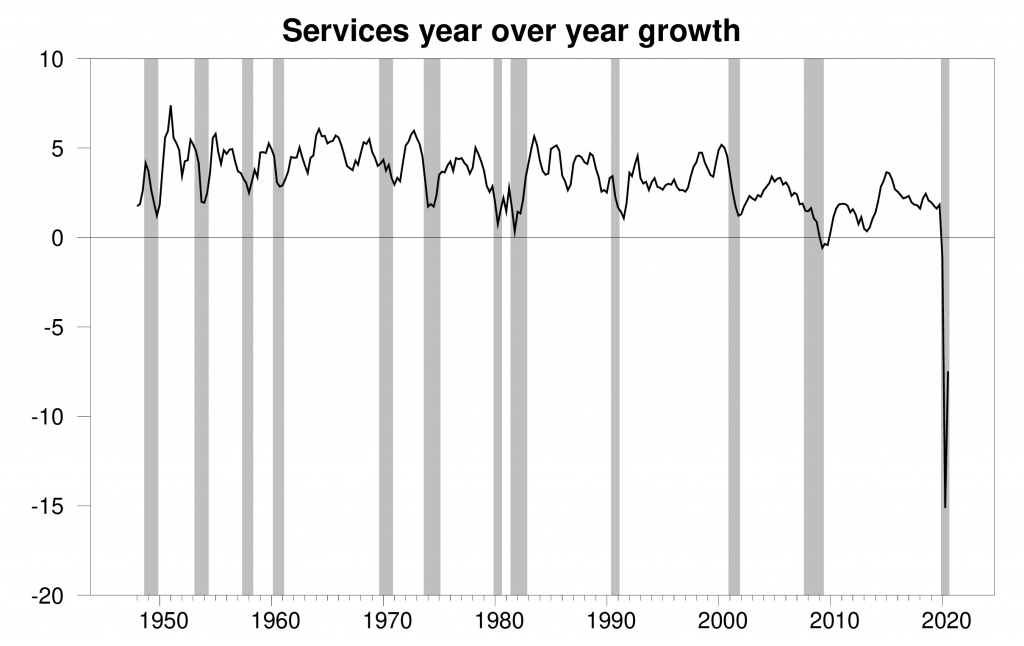
100 times the difference between the natural log of real consumer purchases of services in quarter t and the value in quarter t-4. Raw data constructed from FRED
By contrast, purchases of consumer durables usually take a bit hit in a recession. The decrease in Q2 was pretty minor, and Q3 saw a big boom that now puts durables way up relative to the start of the year. Money saved from restaurants and travel is showing up in spending on big-ticket items.
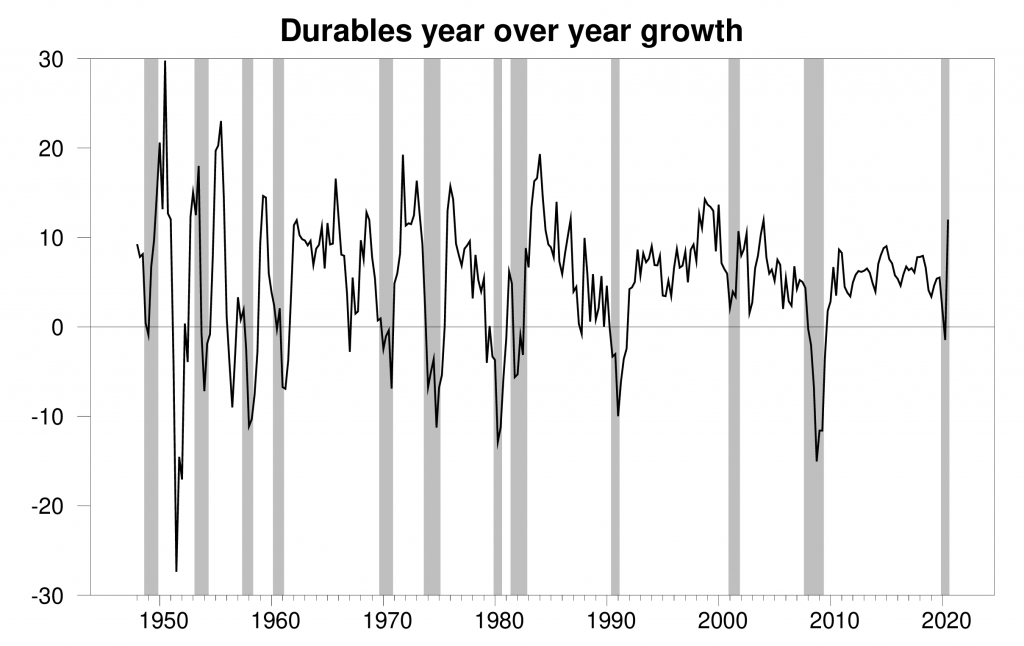
100 times the difference between the natural log of real consumer purchases of durables in quarter t and the value in quarter t-4. Raw data constructed from FRED
Investment spending is usually the big story in recessions. As of Q3, investment is still down on net, but by much less than we see in a typical recession.
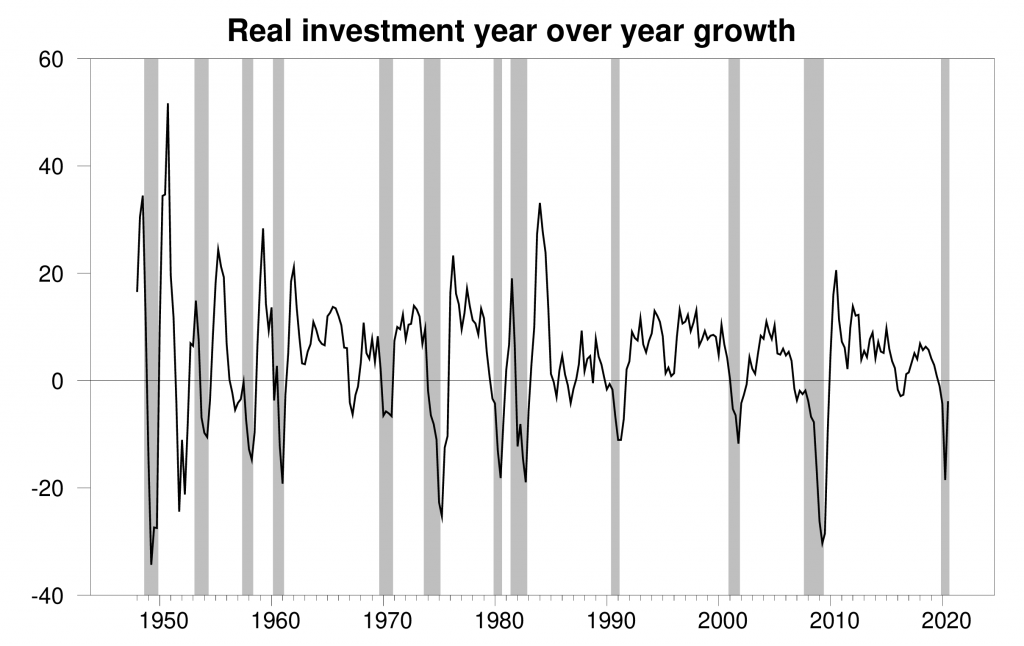
100 times the difference between the natural log of real investment spending in quarter t and the value in quarter t-4. Raw data from FRED
Here’s how the various broad components contributed to the annualized percentage growth rate each of the last 4 quarters:
So where does that leave us? Both the recession and the recovery now under way are very, very different from anything the U.S. has experienced historically. Traditional business cycle dynamics arising from durable and investment spending have so far not been a factor. Coping with the pandemic itself should be the top priority.
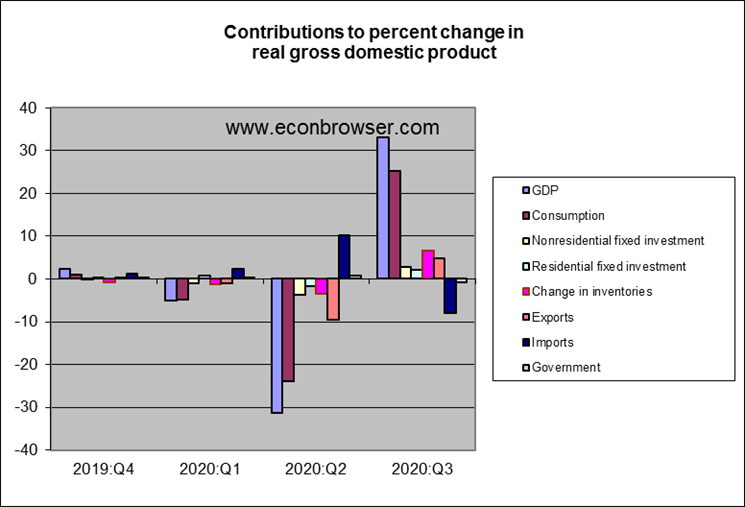
If you held a gun to my head and said “You must choose one single way to measure changes in GDP over time, or else…….” I might go ahead and say “OK, natural log”. However, when I look at these log numbers or line graphs, I’m left thinking it really camouflages the human cost. Now a person could reply “Yeah, so, just about any method/graph you can choose under the sun might not visually display the human cost.” Nonetheless I think it deems being expressed and stated “out loud”.
This is a great post by Professor Hamilton though and very edifying.
There is that darned V shape again, at least if one looks at the second and third quarters.
Then comes the 4th quarter and the v is punched in the eye causing a droop.
I made comments similar to this post earlier today on a different site. The use of annualized data is convenient, but not really necessary. And your point about a greater percentage gain than the percent lost to break even was also my observation, but I used 33% drop offset by 50% gain as an example for simplicity sake because most people are familiar with thirds and halves.
It’s not totally unexpected with the money that was pumped into the economy and won’t be sustainable. Full recovery won’t be achieved until the states drop restrictions on the leisure and hospitality sector which also dampens some of the other sectors. For example, here in Michigan, the state’s Department of Health and Human Services acting as a proxy for Gov. Whitmer, who had her executive order overreach slapped down by the state supreme court, put an even bigger damper on the leisure and hospitality sector: https://www.detroitnews.com/story/news/local/michigan/2020/10/29/michigan-puts-new-covid-19-restrictions-gatherings-restaurants/6072637002/
Yeah, I think I’ll just get some food and wine at Costco.
Which, of course, means recovery will happen when we overcome the pandemic instead of pretending it will go away. You forgot to mention that part. Mask up!
From the Washington Examiner:
No matter the state, the problem with COVID-19 is the same: nursing homes, not schools, not restaurants, not football games.
Bruce Hall Try thinking this through. Nursing homes account for the lion’s share of deaths because nursing homes account for the lion’s share of people with weak immune systems. No one has figured out a way to keep the elderly from being exposed to COVID. If they aren’t in nursing homes, then they have to live with another caretaker. And that caretaker is as at least as likely to be infectious as a nursing home worker.
And deaths are not the only bad outcome. Young and healthy people end up in hospitals as well. They may not die, but they suffer and put hospital staff at risk.
You’ve been posting a lot of nonsense lately. If you don’t like mandates to wear masks or limit the size of MAGA rallies or restrict indoor dining and drinking, then please tell us what you think should be done. You’ve had plenty of opportunities, but whenever you’ve been challenged to put up or shut up, you choose to run away and hide for a few days only to repeat the same old nonsensical posts from far right media.
“Nursing homes account for the lion’s share of deaths because nursing homes account for the lion’s share of people with weak immune systems. No one has figured out a way to keep the elderly from being exposed to COVID. If they aren’t in nursing homes, then they have to live with another caretaker. And that caretaker is as at least as likely to be infectious as a nursing home worker.”
… and yet you have little evidence that the other 40% of COVID deaths that occur in the 65+ years olds who die live with a caretaker. If you’ve lived for 65 years and don’t have enough sense to take precautions with all of the information that is going around, then perhaps you are a prime candidate for the Darwin Award. That should not mean that the rest of the population should put their lives on hold or whole sectors of the economy ruined.
“You’ve been posting a lot of nonsense lately. If you don’t like mandates to wear masks or limit the size of MAGA rallies or restrict indoor dining and drinking, then please tell us what you think should be done”
How about doing what is best for yourself? There are no laws that say you can’t protect yourself unless the government shuts down the leisure and hospitality sector. Or are you saying that the general population is too stupid to take precautions without an authoritarian leader (I’m guessing that’s what you think)?
So, am I going to wear a mask when I’m in a golf cart playing a round on a breezy day? Hardly. Will I wear one when I am indoors with many strangers? Sure. I’ll also carry hand sanitizer. Should my 8-year old grandchild wear a mask when playing outdoor soccer? No. Must she. Yes. Ridiculous? Yes.
Authoritarians see no logical limit to their powers.
Bruce,
You ask “How about doing what is best for yourself?” Wow, do you not get it? Masks are not about protecting “yourself,” although they actually do help do that somewhat. They are about protecting other people. Or is that not a concern of you, and you think it should not be a concern of anybody else, just like a drunk driver should not be concerned about how they might kill another driver?
Bruce Hall How about doing what is best for yourself? There are no laws that say you can’t protect yourself unless the government shuts down the leisure and hospitality sector.
You’re missing the point. If you behave responsibly, then there is no practical difference between your doing so voluntarily or involuntarily. The economic effect on the leisure & hospitality sector is exactly the same. It doesn’t matter whether I don’t go to a restaurant because the government tells me I can’t or whether I don’t go because I choose not to go. The economic result is exactly the same. There may not be any legislative laws that say you can’t protect yourself, but there are epidemiological and biological laws that say you can’t. Your protection from COVID does not depend on what you do; it depends on what others do. My wearing a mask does very little to protect me, but it does a lot to protect you. The over 65 crowd that doesn’t require a caretaker still has to interact with the rest of the world, which means that you have to compel the rest of the world to act responsibly. You keep harping on this personal responsibility bugaboo. Personal responsibility doesn’t mean watching out for yourself; it means watching out for others who are not as responsible. That’s the part that you don’t seem to get.
Or are you saying that the general population is too stupid to take precautions without an authoritarian leader
Well, take a look at the maskless MAGA crowds who cheer their very own authoritarian leader. Are they stupid? Yes. Do I care if they get sick and die due to their own stupidity? No. Good riddance. The problem is that those are the same idiots who will infect other people who aren’t as stupid and irresponsible.
Should my 8-year old grandchild wear a mask when playing outdoor soccer? No. Must she. Yes. Ridiculous? Yes.
Is that an especially burdensome requirement? No. Sounds like you’re complaining about trifles. This isn’t about 8-year old kids wearing masks; it’s about compelling irresponsible adults to behave responsibly for the sake of others. You probably think laws against drunk driving are in offense against your personal liberty.
“There are no laws that say you can’t protect yourself unless the government shuts down the leisure and hospitality sector.”
This was Bruce Hall’s libertarian reply? I guess he is really that dumb – not realizing that this virus is a gigantic externality. Yea – I know you have tried to explain this reality many times but it seems it is not getting through to his little brain. Hey – is one of the effects of this virus permanent damage to the brain? I guess that would explain Bruce’s declining mental state.
This isn’t about 8-year old kids wearing masks; it’s about compelling irresponsible adults to behave responsibly for the sake of others. You probably think laws against drunk driving are in offense against your personal liberty.
“Compelling” is the point, isn’t it? Authoritarians love to “compel”. It gives them a tingle in their leg.
So much power grabbing in the name of public safety. Let’s try it now and if it works, well, wait until next time! Why then we can declare that this group can’t get together, but that group can riot… all for public safety.
Well, why don’t we just require anyone over 44-years old to be restricted to their home and if they don’t have a home then herd them into a “facility”? After all, the 45+ demographic account for over 95% of the deaths. Pretty much everyone else has mild symptoms or recovers pretty quickly. Let them go to school or work or a night out on the town without interference.
We’ll just compel people to be safe who need to be controlled. https://www.heritage.org/data-visualizations/public-health/covid-19-deaths-by-age/
Let’s listen to the science.
https://www.dropbox.com/s/6gu6prgcb73vasq/COVID-19%20Cases%20and%20Deaths%2010-25-20.gif?dl=0
Bruce Hall Authoritarians love to “compel”.
Let me get this straight. Telling people to wear masks is your idea of authoritarianism? You’re worried about authoritarians, but yet you’re a true believer in the Trump cult. The sad thing is that you don’t realize how pathetic and desperate your posts have become lately.
Why do you bother with this nonsense since you have said repeatedly that the death of an old person does not matter. Wait, wait, your boy Don Jr. said that no one is dying from COVID-19. Over 800 deaths per day but to you and Jr. – none of these people matter. MAGA!
Weddings, house parties and indoor political gatherings are also problems. Ask all those people who got sick at Barret’s nomination party.. Funny how you left those off you list. Well, not funny, actually. At this point, your efforts to mislead have become boring.
You are pretending that government restrictions are the sole cause of the decline in travel and dining. That’s obviously untrue. I live in a place that allows indoor dining. Most restaurants are struggling nevertheless. I’ve just moved from Trump’s “ghost town” where not even all of the outdoor dining seats were regularly in use. Airline are allowed to book passengers, but have had to make deep cuts in flights. Many people are choosing to avoid infection beyond what governments require.
It’s sad that you, and you ideological masters, think your agenda requires dishonesty to succeed. In fact, the constant reliance on dishonesty shows that you know your policy goals are harmful to the general public. Nice agenda you’ve got.
So, you have no problem with the government forcing restaurants to get your personal information or you being forced to provide it?
https://www.detroitnews.com/story/news/local/michigan/2020/10/29/michigan-puts-new-covid-19-restrictions-gatherings-restaurants/6072637002/
Wouldn’t it be easier to implant gps devices in people?
Bruce Hall Do you have a problem with government forcing restaurants to ask for your personal information before serving you alcohol? No one is forcing you to go to a restaurant. If there is a COVID outbreak at a restaurant, then it’s entirely legitimate for government to do contact tracing, and to do that requires your providing personal information.
Wouldn’t it be easier to implant gps devices in people?
Well, you’ve got one in your phone.
Bruce Hall did not realize that people can be traced via their smart phones? Oh wait – Bruce has a dumb phone in honor of his really deficient brain. Never mind!
“So, you have no problem with…” Wow! Brucey, that’s weak even for you, and that’s saying something.
This “you have no problem with…” or “you support…” trick is just another little bit of Brucey’s intellectual fraud. Here’s how this works. When someone on the wrong side of facts and logic, like Brucey usually is, wants to distract attention from the weakness of their position, they try to change the subject. Brucey is pretending that what I wrote earlier implies that I support the view he is assigning to me. I’m now supposed to indignantly defend myself, so that the discussion veers away from the weakness of Brucey’s position. Another way to do much the same thing is “what-about-ism”. Popular cases of what-about-ism are “What about Hillary’s emails?” and “What about Benghazi?”
The fact is, Brucey is trying to get me to defend a cockamamie position he made up to distract from the fact that his own position is indefensible and immoral. Just another cheap debating trick.
By the way, an easy way to know that someone holds a certain position is when that person says they hold that position. If I’d written “we should all be forced to have implanted tracking devices”, it would be reasonable to assume that I hold that view.
If I have not said anything of the kind, then it’s silly to assume I hold that view, and Brucey is merely engaging in another cheap debating trick.
Y’all know the Koch brothers provide training in debating tricks, right? You, too, can become as sleezy as Brucey.
JDH I’m curious about the strong positive change in inventories. After five consecutive quarters of negative contributions to GDP, this quarter there was an unusually strong positive bump. Intuitively I would have expected strong consumer spending would prevent inventories from accumulating. Is there some risk that suppliers have overreacted to shortages in Q1 and Q3? Is this the signature of a bullwhip effect in the supply chain?
Bruce Hall You keep riding that same hobbyhorse. Demand for service sector jobs is weak because the virus is still in control of the economy. Michigan has one of the lowest infection rates in the country. If you want to have a sit-down dinner with a side of COVID, then go to North Dakota. You should thank Gov. Whitmer for saving your senior citizen butt.
“Demand for service sector jobs is weak because the virus is still in control of the economy. Michigan has one of the lowest infection rates in the country. If you want to have a sit-down dinner with a side of COVID, then go to North Dakota. You should thank Gov. Whitmer for saving your senior citizen butt.”
We have all come to realize that “infection rates” (cases) are pretty meaningless as a measure since it all depends on the number of tests and the positivity rate. The more asymptomatic people you test, the lower your “infection rate”.
https://www.bea.gov/system/files/qgdpstate1020.png (policy effect)
https://www.statista.com/statistics/1109011/coronavirus-covid19-death-rates-us-by-state/ (policy impotence)
If individuals do not know how to protect themselves by now, they never will.
Data are data; politics are politics.
Bruce Hall it all depends on the number of tests and the positivity rate.
You need to cut back on your daily dose of Fox Noise misinformation. Hospitalizations track infections. Positivity rates are not a function of the number of tests. Positivity rates are highly autocorrelated, which is what you would expect from a highly contagious virus.
If individuals do not know how to protect themselves by now, they never will.
There are a lot of stupid people out there. And if there were some way of isolating those stupid people so that they would be the only ones who caught the virus, then I’d be fine with that. One less stupid person in the world is always a good thing. But there is no way of protecting the smart folks from the stupid folks. And you’re also contradicting yourself. The way people protect themselves is by not going to leisure & hospitality establishments. But yet you seem to think that if states did away with orders to regulate leisure & hospitality establishments, then those businesses would thrive. But that only happens if people don’t take precautions and choose to go to bars and restaurants. You cannot be both responsible and support indoor dining and drinking. You’re contradicting yourself. If you truly believe the nonsense you post here, then I invite you to take a trip to North Dakota and hit as many bars and restaurants as you can in order to help out the leisure & hospitality sector.
“There are a lot of stupid people out there.”
It is turning out to track these people. They tend to wear MAGA hats.
Slugger,
Two guesses:
Autos are selling well and the new models are now in showrooms. If Covid slowed production, there would need to be some catch-up now.
Stocking for the holidays may have had a similar delay due to Covid.
When inventory accumulation doesn’t match seasonal patterns, you get a big swing.
macroduck Thanks. My understanding is that the NIPA inventory numbers refer to inventory of final goods. What concerns me is how out-of-seasonal swings in final demand affect upstream suppliers of inputs and demand forecasts for intermediate level suppliers. Mismatches between final demand signals and intermediate demand signals is a major source of the bullwhip effect. The usual way of minimizing the bullwhip phenomenon is by having a well integrated supply chain that looks at changes in final demand rather than demand for each supply echelon. I don’t know if that strategy works in a COVID world.
Strikes me as a big deal in what is often a big swing factor. Swings in consumer spending don’t often outweigh swings in inventories by as much as has been the case this year, which is of course the origin of the bullwhip.
Anyone know how to put job losses on a natural log curve??
https://twitter.com/johngramlich/status/1321905645856215040
Asking for a friend……..
It’s just “news” “and stuff”. donald trump has already shown we have no need for journalism anymore. Shooting blind is the “conservative” thing to do apparently. Or is shooting blind a “family values” thing?? I get so “confused” anymore. I’m certain someone will enlighten me. Lack of news works for Putin’s oligarchs in Russia, so what am I worrying about anyway??
Moses,
Is this the same friend you emailed your forecast about the pattern of US GDP for the second quarter to and promised not to reveal your forecast because, wow, it deserves to be as secret as Trump’s tax returns?
I could tell you, but then…….
I will tell you what it didn’t say~~~It didn’t claim a V recovery.
And you were wrong about that, even though you are now whining on the newest thread that Menzie is saying that is what it looks like. You jhave clearly forgotten that some time ago a lot of other people said that is what it looks like. Nobody has said it looks like anything other than that.
You have been just wrong, wrong, wrong, even though that has not stopped you from endlessly mocking me for having been right. Just how messed up are you? Truly sick, you are, Moses, truly sick.
no-one believes an annualised rate which is why you yanks are the only wood-ducks publish such a number.
Even this ‘advanced’ estimate has numbers in it that are not actual data.
Amazing
Astounding V recovery. What will next be interesting is a measure of individual state’s recovery and what factors cause local recovery better than or worse of 33.1.
Ed
You need to go back to Sesame Street and learn the difference between V and K.
pgl,
It is both a V and a K, the former in the aggregate, the latter when one looks at different income levels groups.
We actually have some evidence on that point from the Spanish flu era. Localities which too aggressive steps to prevent the spread performed better that those which did less in the aftermath of the epidemic. Using growth during the pandemic to judge policy response to the pandemic is just about as short-sighted as can be. Either short-sighted or dihonest.
Do note that while Jim here is posting the overall quarterly numbers which show the V that I was the firs non-Trumpist around here to forecast, Menzie has been putting up a lot of posts showing a flattening of the V, which I also forecast. But it is not yet visible in these quarter to quarter numbers.
Ed did not mention that stock market boom? Oh wait!
https://www.cnn.com/2020/10/30/investing/dow-stock-market-today/index.html
It has been a messy week for the stock market. With only four days to go until Election Day, rising Covid-19 infections and uncertainty about further government stimulus to help the economy, there’s plenty for investors to worry about. Stocks had their worst week since March, when the market tumbled under the first wave of coronavirus infections and lockdowns — and one of their worst weeks of the year as a whole. All three major indexes also recorded the second straight month of losses.
Astounding. If you like that 33.1% Trump recovery, how would you rate the Dow recovery under Obama? More astounding?
As you no doubt recall, Ed, by early March, 2009, the Dow bottomed our an astoundingly low 6466.
But under the leadership of President Obama, the Dow made an astounding recovery.
By year’s end, the Dow closed at 10428. That was —to use your modifier—an astounding 59% increase in a ten month period.. Or, an average monthly increase of 5.9%!
Since Trump has always pointed to the importance of Dow increases under his leadership—as have you—may We assume you were also astounded at this magically astounding turnaround?
The same release has disposable personal income down some $630 billion and personal savings down about $2 trillion.
So much for sustainability.
Professor Hamilton,
At this time, prior to complete data for October 2020, what is an acceptable way to attempt a (reasonable) forecast of 2020Q4 GDP? I notice that an ARIMA model using a dummy for 2020Q2 shows a forecast of -1.7% annualized for 2020Q4. Would this be a reasonable forecast attempt or the forecast of a “dummy”?
AS, i know you’ve addressed Professor Hamilton, but i have to interject that it’s a fool’s errand to try to forecast Q4 GDP while this pandemic is raging….half the country might be hospitalized during the Christmas shopping season, for god’s sake; no one can know…none of one’s normal assumptions apply…
one thing working against the negative print you suggest was the +1.4% increase in September PCE (+1.2% real)…that means even modest decreases in PCE from that level in the following months will still be above the PCE of August & July, biasing your 4th quarter GDP print upwards..
I like how Pence said it: “GDP is up MORE than 33%!” Yeah, 33.1%
Funny that he didn’t say “COVID deaths up by MORE than 62% during the 3rd quarter!” Or “COVID infections up by MORE than 189% during the 3rd quarter!”
An increase less than 8% that was annualized and you say it is above 33%? Seriously Sammy – for someone who went ape $hit over a normal duel scaling of two series with clear graphical references (I’ll let Menzie splain this to you once again) this comment shows you are truly one two faced lying dumb troll.
Astounding? See astounding Obama Dow recovery above.
“no-one believes an annualised rate which is why you yanks are the only wood-ducks publish such a number.”
It’s a rate, expressed with a denominator of one year. That is understood.
When you ask someone how fast they are driving and they say 30, do you freak out. OMG, 30 miles per minute? Do you demand that the speedometer read 0.5 miles per minute instead of 30 miles per hour?
Even if I am only driving to the store 5 minutes away it find it more useful to say I am driving 30 miles per hour rather than 0.5 miles per minute. I prefer a rate of change, expressed with a common, consistently used denominator. In this case I prefer to express the rate of change using the same denominator whether I’m talking about change over one quarter or one year.
Yes, well lots of people and other nations as well do not use these SAAR numbers. When the Washington Post reported on this on its front page this morning, it simply reported the quarter to quarter result not annualized, 7.6%.
I just read Prof. Krugman’s article in the NYT published last February about why MMT is wrong. Deficit spending on a massive scale is apparently very dangerous. The following chart from FRED would seem to disprove that assumption:
https://fred.stlouisfed.org/series/FYFSD
And for those worried about the dollar losing its value, that happened a long time ago:
https://fred.stlouisfed.org/series/CUUR0000SA0R
The dollar lost “it’s value”? No, the dollar lost value. Different concept. Ask all those reserve managers in countries throughout the world who hold dollar assets. They know the difference.
Yes, the dollar has lost 95% of its 1933 value, yet reserve managers around the world want to get ahold of as many as possible. They are not as interested in acquiring gold or bitcoin, however.
Interesting fact about the U.S. trade deficit: it enables countries with weaker currencies to acquire dollars thereby strengthening their financial position. IOW, if the U.S. ran a trade surplus, the world economy would soon be short of dollars. China is a good example of a country which massively strengthened its financial position by acquiring dollars. Of course, strengthening one’s financial position by acquiring dollars can go too far: Japan strengthened the yen so much that its exports are now uncompetitive.
Your claim about the direction of causation is dubious. It assumes reserve accumulation is a passive activity. If reserve accumulation is an active policy goals (it is) then causation runs from reserve accumulation to trade, not the other way around.
“the dollar losing its value”????
Gee most nations have seen their CPI rise a lot over the past century. For the dollar to have lost value to other currencies – you would have to plot nominal exchange rates. When one does that I bet the “value” of the dollar has actually increased.
Good point, but not the one politicians are talking about. You know the old “loaf of bread” argument, right? In 1933, a loaf of bread cost a dime. Now it is $2, so the Fed is out of control and “debasing” the dollar. Time to go back to gold and silver coins.
Guess who thinks that is correct? Our newest Justice of the SCOTUS whose “originalism” argument is predicated on Article 1, Clause 8, Section 5 of the Constitution which gives Congress the power “to coin money” and therefore by the principle of expressio unius est exclusio alterius, Congress does not have the power to create paper money. None other than James Madison in Federalist 44 took the same position:
“The loss which America has sustained since the peace, from the pestilent effects of paper money on the necessary confidence between man and man, on the necessary confidence in the public councils, on the industry and morals of the people, and on the character of republican government, constitutes an enormous debt against the States chargeable with this unadvised measure . . . . The power to make any thing but gold and silver a tender in payment of debts, is withdrawn from the States, on the same principle with that of issuing a paper currency.”
The Pestilence of Paper Money indeed. What would Mr. Madison think of today’s immorality? Justice Barrett to the rescue!
Madison and the Federalist Papers are a good guide to the debates of the day, but do not always represent the winning side in those debates, nor do they necessarily represent the right answer.
The U.S. engaged in a great experiment in non-soveriegn printing of money in the early days: https://en.m.wikipedia.org/wiki/Early_American_currency
That is part of the context for Madison’s comments. Miss that and you misunderstand Madison.
Here’s the form of Paul M’s argument: bread costs more now, so the Fed is out of control.
Here’s the form of a syllogism: Major premise; Minor premise; Conclusion
See what’s missing? No Major premise. Paul has a sub-rosa premise lurking in the background. Something along the lines of “any change in bread prices means the central bank is out of control.” That is not, to my knowledge, a widely held view.
Note also that Paul is claiming that the Fed is out of control and is debasing the dollar – present tense – while the dollar lost “it’s value” (sic) a long time ago – past tense. Another logical lapse.
Semantics are interesting but not persuasive.